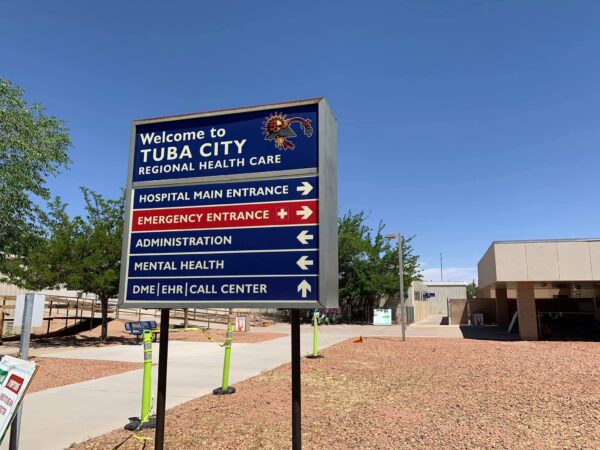
- Details
- By Levi Rickert
Navajo Nation President Nez meets with health care workers and federal officials
WINDOW ROCK, Ariz. — The Navajo Department of Health in coordination with the Navajo Epidemiology Center and the Navajo Area Indian Health Service, reported 147 new cases of COVID-19 for the Navajo Nation and a total of 119 deaths as of Wednesday. The total number of positive COVID-19 cases for the Navajo Nation has reached 3,392, many of whom have recovered or are in the process of recovering from the virus.
The 3,392 confirmed positive cases on the Navajo Nation include the following counties:
- McKinley County, NM: 912
- Apache County, AZ: 889
- Navajo County, AZ: 697
- Coconino County, AZ: 335
- San Juan County, NM: 410
- San Juan County, UT: 57
- Socorro County, NM: 26
- Cibola County, NM: 37
- Bernalillo County: 3
- Sandoval County, NM: 26
Navajo Nation President Jonathan Nez and Vice President Myron Lizer said the Nation will have a 57-hour weekend lockdown that will have slightly stricter measures than previous curfews. The order is being finalized and will be issued on Thursday.
During a visit to Alternative Care Sites in Chinle and Shiprock on Wednesday, President Nez told federal officials and health care experts that he wants to see increased use of the facilities constructed by the U.S. Army Corps of Engineers to house positive COVID-19 patients so they can isolate themselves and prevent further spread of the virus.
“We should be using these facilities to their full potential. By that, I mean we need to isolate those who test positive in these facilities, so they don’t take the virus home to their loved ones and spread it even more. Contact tracing is another critical factor for those who test positive. If you test positive, you have a responsibility to document everyone that you’ve come into contact with so they can be contacted and traced,” said President Nez.
President Nez was joined by officials with the U.S. Public Health Service and FEMA’s Emergency Support Function, as they met with health care workers and management from the Tuba City Regional Health Care Center. President Nez thanked all of the health care workers for their dedication and long hours of hard work on a daily basis to help COVID-19 patients. He also listened to their concerns and offered assistance through the Nez-Lizer Administration.
“With some states starting to reopen, it’s giving people the impression that it’s okay to go out into public, but it’s not safe yet. With today’s numbers, it’s clear that everyone needs to step up and hold each other accountable to stay home. Our law enforcement officers are stretched thin and we don’t have the manpower to enforce the shelter-in-place order and the daily and weekend curfews around the clock. It’s very disheartening to see more and more traffic on our roads and more people going into border towns, but we’re not giving up. We’re going to look at what else we need to do to bring the numbers down,” said President Nez.
On Tuesday, the Navajo Nation extended its declaration of a state of emergency and the closure of Navajo Nation government offices until June 7, to minimize the spread of COVID-19.
The Nez-Lizer Administration will host another online town hall on Thursday beginning at 10:00 a.m. (MDT) on the Nez-Lizer Facebook page.
For more information including reports, helpful prevention tips, and more resources, please visit the Navajo Department of Health’s COVID-19 website at http://www.ndoh.navajo-nsn.gov/COVID-19. To contact the main Navajo Health Command Operations Center, please call (928) 871-7014.
_________________________________________________________________
To Donate to the Navajo Nation
The official webpage for donations to the Navajo Nation, which has further details on how to support the Nation’s Dikos Ntsaaígíí-19 (COVID-19) efforts is: http://www.nndoh.org/donate.html.
_________________________________________________________________
For More Information
For more information including reports, helpful prevention tips, and more resources, please visit the Navajo Department of Health’s COVID-19 website at http://www.ndoh.navajo-nsn.
For up to date information on impact the coronavirus pandemic is having in the United States and around the world go to: https://www.worldometers.info/coronavirus/country/us/?
More Stories Like This
Native News Weekly (August 25, 2024): D.C. BriefsUS Presidents in Their Own Words Concerning American Indians
Native News Weekly (December 14, 2025): D.C. Briefs
Wounded Knee Massacre Site Protection Bill Passes Congress
Two Murdered on Colville Indian Reservation
Help us defend tribal sovereignty.
At Native News Online, our mission is rooted in telling the stories that strengthen sovereignty and uplift Indigenous voices — not just at year’s end, but every single day.
Because of your generosity last year, we were able to keep our reporters on the ground in tribal communities, at national gatherings and in the halls of Congress — covering the issues that matter most to Indian Country: sovereignty, culture, education, health and economic opportunity.
That support sustained us through a tough year in 2025. Now, as we look to the year ahead, we need your help right now to ensure warrior journalism remains strong — reporting that defends tribal sovereignty, amplifies Native truth, and holds power accountable.
 The stakes couldn't be higher. Your support keeps Native voices heard, Native stories told and Native sovereignty defended.
The stakes couldn't be higher. Your support keeps Native voices heard, Native stories told and Native sovereignty defended.
Stand with Warrior Journalism today.
Levi Rickert (Potawatomi), Editor & Publisher

